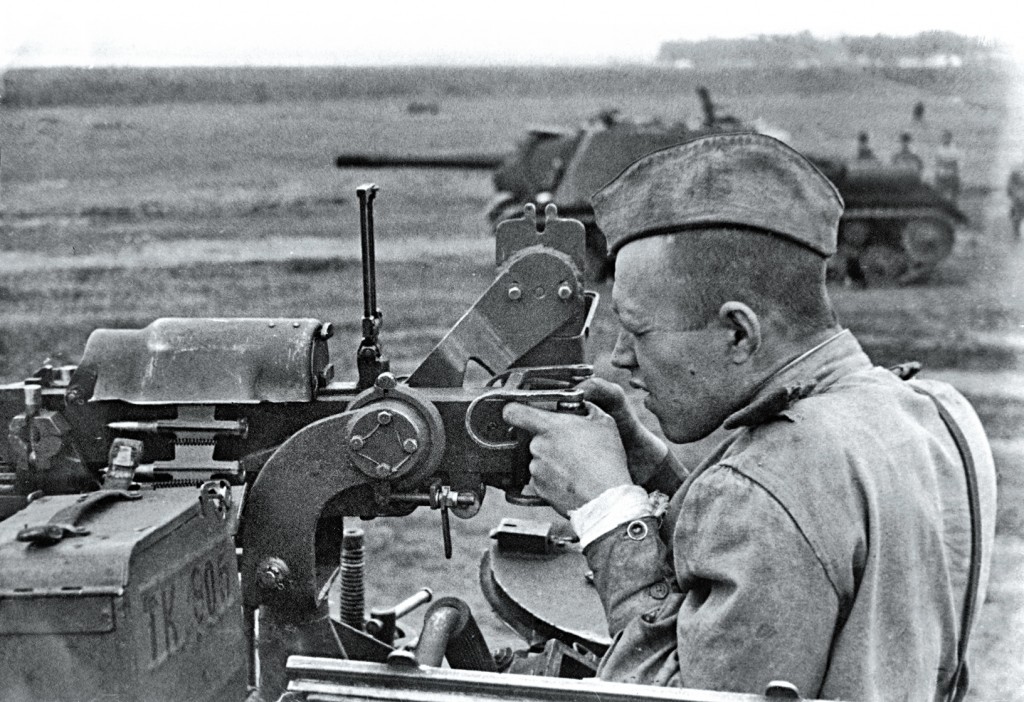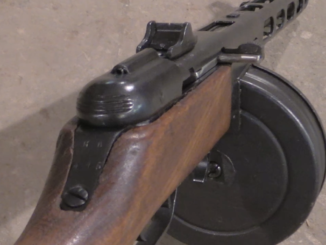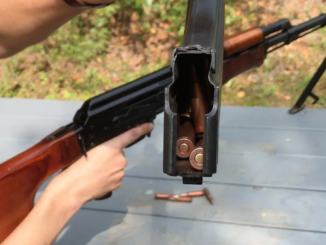
Related Articles

Submachine Guns
Shpagin’s Simplified Subgun: The PPSh-41
After making the decision to mass produce a submachine gun, the Soviet Union adopted the Degtyarev PPD-38 and PPD-40, but this design was too expensive for the huge scale of production that the USSR […]

Light MGs
Vintage Saturday: Maxim-Tokarev
Reader Ruy has sent us this great photo of a very unusual gun in action in the Spanish Civil War – a Maxim-Tokarev “light” machine gun.

Feeding devices
Forgotten Weapons Field Test: 90-Round AK Magazine
Today I am joined by Forgotten Weapons Field Research Assistant Clay to test out one of those super-extended 90-round AK mags that are so often seen at the junk tables of gun shows. How bad […]

Detailed and interesting shot of a DShK M1938 with the early-style “squirrel cage” feed cover.
The armored vehicle in the background is an ISU-152 ( JSU-152 ) 152mm assault gun, based on the IS-2 ( JS-2 ) heavy tank chassis. The ML-20S 152mm gun-howitzer was tremendously powerful and was one of the few Allied anti-tank weapons ( along with the smaller-caliber but higher-velocity 122mm A-19 cannon, mounted in the similar ISU-122 ( JSU-122 ) tank destroyer / assault gun ; this later became the D25S cannon when a new semi-automatic breechblock was added, and the vehicle re-designated ISU-122S or ISU-122-2 ) that could cause serious damage to the frontal armor of a Tiger or Panther at battlefield ranges.
There is a pretty good synopsis of both vehicles, their development, internal layout and derivatives at the http://www.english.battlefield.ru web site. Just enter “JSU-122” or “JSU-152” in the Search Box, then click on Item #3 ( “JSU-122 and JSU-152 Heavy Assault Guns” ), which will be outlined in blue.
I have some interest in artillery Earl (I guess it goes back to time of my service) and read with interest what you say about this particular piece of equipment. My admiration to your knowledge in this field of technology!
I seriously urge your more bloodthirsty (and, oddly, pacifist) subscribers to check out the above english.battlefield.ru website and click the ‘infantry’ tab on the left side of the page. The language seems a little formal because it has come through a translator. No doubt the original tales used much blunter language, but the ones I have read still tell the universal tale of the poor bloody infantry – PBI!
Good recommendation, Thomas, and well said.
Something I like to say in a broader sense, if you don’t mind. It does not exactly relates to technical side of thing, but it does relate to tactics and perception as they were applied. I grew up in heavily politically indoctrinating times in country closely allied to Soviet Union. We were told on daily basis that the Red Army was the master of battlefield in WWII and it was invincible. Naturally, after a while we started to doubt these assertions and even begin (some individuals) to secretly admire German proves, not to say of one time Western Allies – our enemies of the day.
All this has past into hole of time and we do read and see all kinds of other things presented as historical documents and are finding, that not all we were told, but significant amount was actually true. Because of material such as this and elsewhere (including the page Earl refers to) we can read testimonies of tremendous effort put up by Soviets (one has to be impartial since there were other nationalities than Russians) in this heroic struggle. They deserve all the respect, regardless of political system in that era.
And at the end, we can also see that their equipment was not inferior either, their small arms, artillery, tanks and aircraft measured up pretty well with the rest of contestants.
Hi, Denny :
Good to hear from you, as always! It continues to amaze me that you have managed to retain such a truly objective and fair-minded view of the facts of history in spite of your ( and your home country’s ) political experiences at the hands of the opposing protagonists. My respect for you and the fact that you adhere to the truth as best as humanly possible, in spite of what must be temptations to the contrary, has never been subject to doubt, even when opinions have differed.
And this characteristic is also what sets most of the contributors to FW aside from so many others — the willingness to keep an open mind and to think critically about hard facts, as disagreeable as they might be — and not perceptions, however comforting to one’s outlook those are.
I seem to recall from a good while back something Keith had said about the real need for critical thinking — this was true then and is even more so now.
Some reading on DShK HMG by author you all know:
http://sadefensejournal.com/wp/?p=1305
I had a close encounter with “dushka” while marching to place of training in those heady days of August 1968; Russian tank commander cranked his gun and kept our small unit in point of aim. No shots were fired – luckily for us. Luck is like a fire-fly.
Darn it, Denny! You beat me on the draw. Kidding. It is a great article.
I’m just glad for both you and that tank commander that nothing more happened. Yes, the hand of fate falls in strange and sometimes fortunate ways.
Thanks Earl. There was a song in my parents time: “Life is just a chance” (free translate). Yes it can go either way and often it does. I believe the fellow in charge was just playing “chicken” with us.
Great photo, Ian. Here is a very informative and well-illustrated article by our very own Leszek Erenfeicht at Small Arms Defense Journal: http://sadefensejournal.com/wp/?p=1305
this too, was not a russian invension, it is more or les a copy of the Hispano gun.
The birdcadge feed system, works remarkeble good.
Please elaborate, Peter. Which is a copy of the ‘Hispano gun’?
That seems unlikely. For one, the DSHk’s bolt was flapper-locked, which seems like a terrible idea for a cannon. Secondly, both the designs were roughly designed at the same time.
I don’t see any reason why a flapper-locked gun cannot shoot reliably high power ammunitions.
Hey, my friends,…. besides the sight Sergej is looking through, there are TWO interesting things about this picture:
1- the cartridge of his -heavy- machine gun
2- the tank in the background, apparently a German Koenigstiger, probably captured
Keep right on blokes,
Normann
Hi, Normann :
Please see my September 7 / 2013 / 7:07 a.m. post regarding this topic ( the armored vehicle in the background is not a Koenigstiger or a Jagdtiger, but a ISU-152 assault gun ; the ammunition in the feed belt of the DShK M1938 HMG are standard 12.7mm x 108 ball rounds ).